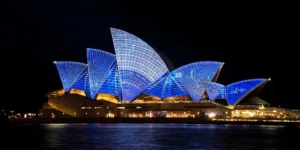Australia is a land abundant with amazing places to visit, so many that it can be hard to work out where you are going to go when you only have a short time to spend in the country.
As recorded in 2017, UNESCO has categorised 19 different places as World Heritage Sites in the country and we think these make for perfect places to visit on a trip down under.
World Heritage sites are notable for their environmental and cultural significance and are often located in amazing areas of natural beauty.
Of the 19 designated that privileged status by UNESCO, there are four mixed sites (consisting of lakes and national parks), 12 natural sites and three culturally important sites.
To help you plan out your trip to Australia better, Freedom Destinations have highlighted 10 of the most amazing that no trip to Australia is complete without.
The Royal Exhibition Building and Carlton Gardens
Located in Melbourne, this is the first purely cultural site in the country. The Royal Exhibition Building and Carlton Gardens hosts many international events and exhibitions and is one of an only a small number of buildings that date back to what is considered the ‘golden age’.
The international exhibition movement of the 19th and 20th century and its global influence are represented fully in the venue. Make room on your itinerary for a trip to it.
Lord Howe Island Group

Thought to have been created around seven million years ago by volcanic activity, this collection of islands is the dwelling place of many different endemic animal species alongside a truly unique family of plants.
Lord Howe Island Group also is the most southerly located coral reef in the world. Consisting mainly of protected nature reserves, this group of islands environment features stunning steep mountain slopes, lagoons and reminders of the volcanic eruptions that took place long ago.
Aquatic-related activities and bird watching are the things most people visit the island group to do.
Purnululu National Park
Purnululu National Park is home to the Bungle Bungle Range, a series of beehive cones that were naturally created from the erosion of the sandstone towers they once were, over a period of around 20 million years.
By far the best way to appreciate the scope of this land is by helicopter. You’ll notice that as you get closer to Bungle Bungle Range, the sandstone beehives appear to change depending on the angle you are facing them at, making this a magical and natural optical illusion.
Australian Convict Sites
It was in 2010 that UNESCO finally recognised the cultural significance of the Australian Convict sites. 11 Penal sites in total can be found and include the infamous Fremantle Prison, Darlington Probation Station, Cascades Female Factory and Cockatoo Island to name a few.
Although they are a reminder of the British Empire’s enduring power and stretch across the globe, the sites created by the British Government to help with the transportation of English prisoners are also culturally significant as the convicts helped to establish the country and are in part responsible for what Australia is today.
The 1st fleet were sent in 1788, and the British Government continued to send prisoners over there for 80 years.
Kakadu National Park
If you are looking for a site that mixes something extremely beautiful with something extremely important culturally, you will not want to miss out on a visit to Kakadu National Park.
Here you will find numerous archaeological sites, cave paintings and truly breath-taking aboriginal rock art as a celebration and tribute to the 40,000 years that the Aboriginal Australians have lived in Australia.
The park itself also includes plateaux, lowlands, floodplains and tidal flats that are home to some awe-inspiring endemic and rare species.
Sydney Opera House
Undeniably, Sydney Opera House is one of the most iconic man-made structures in the world, not just Australia and with good reason. It was surprisingly only listed by UNESCO as a World Heritage Site back in 2007.
As well as being am innovatively designed concert venue, it is also an important cultural centre for the city and country and hosts internationally renowned performances from various musicians and artists.
No-one visits New York without visiting the Empire States Building or London without visiting Tower Bridge, so if you go to Sydney while down under, make sure you visit the Opera House.
Greater Blue Mountains Area
The Blue Mountains are perfect if you are interested in a natural visual spectacle. The Greater Blue Mountains Area covers eight protected areas that are home to numerous endangered animals and features forests, gorges, aboriginal engravings and lots of sandstone.
If you enjoy a good hike, head to the Blue Mountains. The blue in the name can be seen best either late in the evening or early in the morning.
Fraser Island
This is considered to be the world’s largest sand island and is 76 miles long. Rainforests that have remained there for aeons and aeons tower over it and the area consists of a diverse array of environments including sand dunes mangrove jungles, swamps, the rainforests and freshwater lakes.
These spectacular features and the practically untouched coastline make this without question one of the most amazing islands on the planet.
Shark Bay
Although you may be drawn to this beautiful area, Shark Bay has even more to offer than just those sea creatures that have the ability to send a shiver down even the hardiest of men and women.
Three features to enjoy during a visit to Shark Bay include the wildlife, the stromatolites that are thought to have been there for over three billion years and the lush sea-grass beds. You will also find five endangered species of mammals that only call Shark Bay their home – the Western Barred Bandicoot, the Shark Bay mouse, the banded hare-wallaby, rufous hare-wallaby and the boodie.
Great Barrier Reef

Okay, we’ve left the best to last. This is probably the most well-known of all the UNESCO World Heritage Sites found in Australia and is arguably one of the most famous of all Australia’s amazing sites.
This is home to more than 600 islands and an outstanding 3,000 different coral reefs. So big is the barrier reef that is actually possible to see it from space.
However, if you are unable to get into space, it’s best visited on the surface of the earth. It sits off the Queensland coastline and there are a wide variety of different ways you can explore it. Take your pick from what you prefer – scuba diving, cruising, kayaking or snorkelling.
Scuba diving is the best way to get up close and personal with the marvellous sea life. If you are truly fortunate you may catch a glimpse of the large green sea turtles and the dugong, also known as the sea cow.








